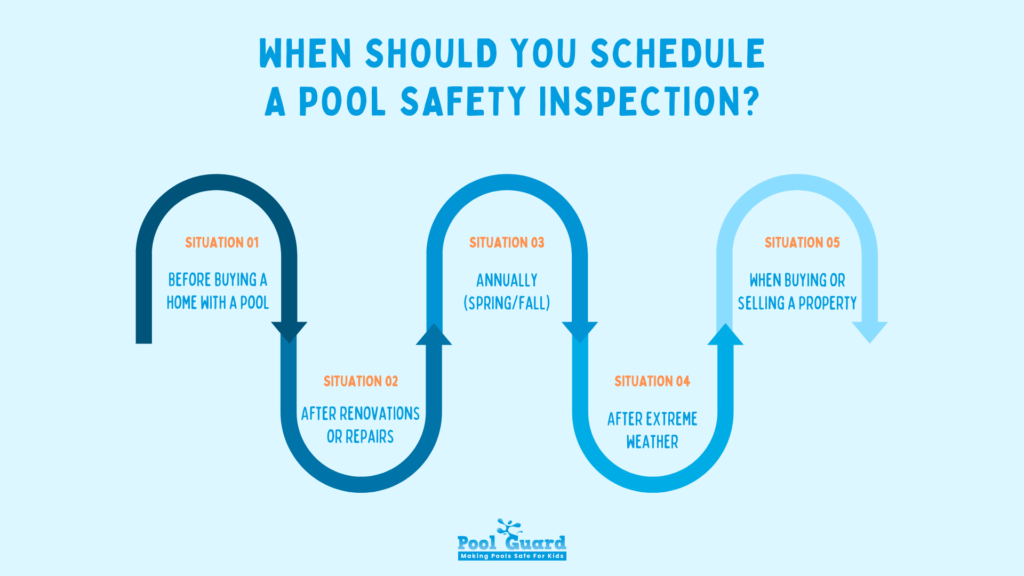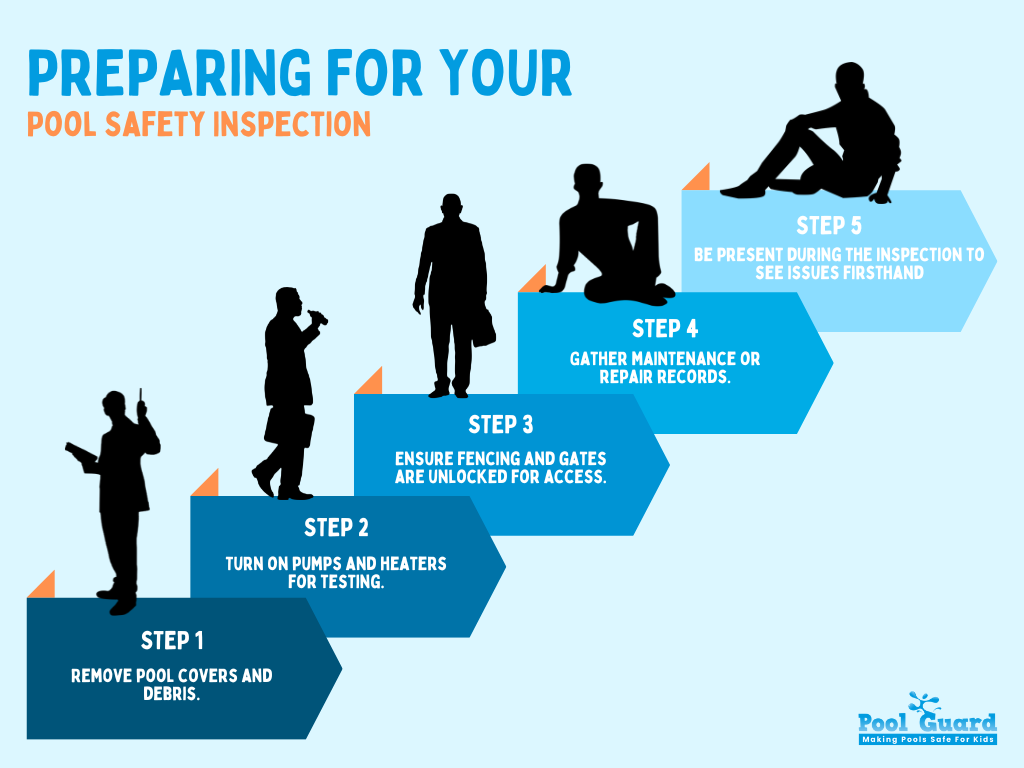Owning a pool means fun, family time, and relaxation – but it also means responsibility. Whether you’re a homeowner, a buyer, or managing a commercial facility, pool safety inspections are the foundation of a safe, compliant, and long-lasting swimming environment.
This comprehensive guide, built from real inspection standards, safety codes, and expert insight, breaks down what happens during pool and spa inspections, how to prepare, and why these checks save lives and money.
A pool may look perfect on the surface, but hidden issues like cracked shells, faulty bonding, or a missing drain cover can turn dangerous — even deadly. According to the U.S. Consumer Product Safety Commission (CPSC), more than 350 children under age 15 drown in pools each year, often in residential settings.
Regular swimming pool safety inspections protect more than your investment — they protect lives. Inspectors catch hazards early, verify compliance with laws such as ASTM F1908, ISPSC, and VGB Act, and ensure fencing, gates, and alarms meet modern pool barrier standards.
💡 Think of a pool safety inspection as a complete wellness checkup for your backyard oasis.
A pool safety inspection is a professional evaluation of your pool’s structure, equipment, electrical systems, safety barriers, and overall compliance with local and national safety standards.
While home inspectors may include pools in general home assessments, certified pool inspectors or CPO® professionals specialize in identifying the technical, mechanical, and regulatory issues unique to aquatic environments.
| Type | Purpose | Who It’s For |
| Residential Pool Inspections | Evaluate backyard pools for homeowners or homebuyers | Homeowners, buyers, sellers |
| Commercial Pool Inspections | Check compliance in public facilities, hotels, HOAs, and schools | Facility managers |
| Pool Fence Safety Inspections | Assess gates, latches, and barrier compliance | All pool owners |
| Pool and Spa Safety Inspections | Include spas, hot tubs, and water features | Homeowners, resorts |
| Pool Inspections for Home Buyers | Conducted before closing on a home | Real estate buyers |

A qualified pool inspector follows a structured process that reviews every part of your pool system – from surface to circulation.
Inspectors examine the pool shell, liner, and decking for cracks, stains, leaks, or settling.
Even minor structural issues can lead to costly leaks or safety hazards.
Decks must drain away from the pool, remain even, and provide non-slip surfaces.
Inspectors check for:
A deck that slopes incorrectly can send runoff into your pool — and into your wallet.
It focuses on physical protection: fence height, latch position, gate swing, spacing, and climb resistance. Inspectors also verify that alarms and safety covers meet ASTM F2286 standards and that no climbable objects are within 36 inches of the fence line.
One of the most important parts of pool safety barrier inspections, this step ensures your pool fence, gates, and alarms comply with code:

Swimming pool fence inspections also verify signage (“No Diving,” “Children Must Be Supervised”) and safety covers are functional.
Your pool’s mechanical heart is its circulation system – pumps, filters, heaters, and plumbing lines. Inspectors check:
Missing a leak or malfunctioning filter can spike energy bills and cause algae blooms or equipment burnout.
Electrical issues are among the most dangerous hazards inspectors encounter.
They verify:
True fact: The National Electric Code (NEC 680) mandates GFCI protection for all outlets within 20 feet of water.
Even if the water looks clear, improper chemistry can irritate skin, damage equipment, and harbor bacteria. Inspectors may test for:
Cloudy water or unbalanced pH often signals circulation or filtration issues.
Inspectors confirm all required safety and rescue gear is present and functional:
They’ll also assess diving boards, ladders, and slides for secure anchoring and proper design.
Modern pools may include automated controls, app-linked systems, or saltwater generators. Inspectors test these for:
Smart monitoring can enhance safety, but only when systems are maintained and properly configured.
| Situation | Why It Matters |
| Before buying a home with a pool | Identify safety or repair issues before closing. |
| After renovations or repairs | Verify proper installation and compliance. |
| Annually (spring/fall) | Maintain safe operations and catch early wear. |
| After extreme weather | Storms and freezing can crack surfaces and damage plumbing. |
| When buying or selling a property | Protect buyer confidence and avoid last-minute surprises. |
Tip: The ideal inspection season is mid-spring through late fall, when equipment can be tested under operating conditions.

Based on data from industry professionals and inspection reports nationwide, these are the most frequent problems identified:
Each of these can lead to fines, shutdowns, or serious safety incidents if ignored.

Failure to comply can result in pool closures or license suspension.
The cost varies by size and complexity, typically $150–$600 for residential pools and higher for commercial venues.
However, early detection of a single hidden leak or bonding failure can save thousands in structural repairs and insurance claims.
“A $300 pool inspection can save a $10,000 problem.” – Certified Pool Inspector, Florida Home Inspection University
Before your inspector arrives, you can make the process smoother by reviewing your pool safety checklist and addressing any visible issues in advance:
Being present during the inspection helps you see issues firsthand and ask relevant questions.

Pool safety isn’t a one-time checklist — it’s a habit of prevention.
By investing in regular pool and spa safety inspections, you ensure compliance, protect your loved ones, and maintain your property’s value.
At Pool Guard™ USA, we believe the safest pool is one that’s inspected, secured, and surrounded by certified safety barriers and fences that meet or exceed ASTM and state standards.
Ready to make your pool safer? Explore Pool Guard’s removable mesh pool fences, self-closing gates, and professional safety inspection partnerships to protect what matters most.
Most residential pool inspections take 1–2 hours, depending on pool size, number of systems (heater, spa, automation), and accessibility. Commercial inspections can take several hours due to health-code testing and documentation.
A Certified Pool Inspector (CPI) or Certified Pool Operator (CPO®) is ideal. These professionals are trained under the NSPF or PHTA to evaluate water safety, mechanical systems, and code compliance. In many states, pool barrier inspections must also be done by a licensed contractor or safety fence specialist.
Yes. Home inspectors typically perform only a visual overview, not full pressure tests, electrical bonding checks, or compliance verification with VGB Act and ASTM F1908. A dedicated pool and spa inspection ensures your system meets legal and safety requirements.
For residential pools, at least once a year – ideally in spring before the swim season.
Commercial pools are typically inspected quarterly or by local health departments 2–4 times annually to maintain operational permits.
If your pool doesn’t meet safety or code standards, the inspector issues a report of deficiencies. Common failures include missing drain covers, non-latching gates, and improper bonding. Once repairs are made, a reinspection can certify compliance.
Requirements vary by state and county. For instance:
They can identify signs of leaks (wet soil, cracked tile, low pressure), but not all inspectors perform full pressure testing. Leak detection specialists may be called for confirmation.
Absolutely. Many inspectors issue a pool safety compliance certificate – often required for home sales, rental listings, or insurance purposes. This certificate confirms your pool meets current state and ASTM standards.
Many do. Insurers often request proof of safety compliance (including fencing, gate latches, and alarms) before issuing or renewing homeowner policies. A valid inspection report can reduce liability and even lower premiums.
Please fill out the form below with your information. Your local dealer will be notified about your inquiry.
Please fill out the form below with your information. Your local dealer will be notified about your inquiry.